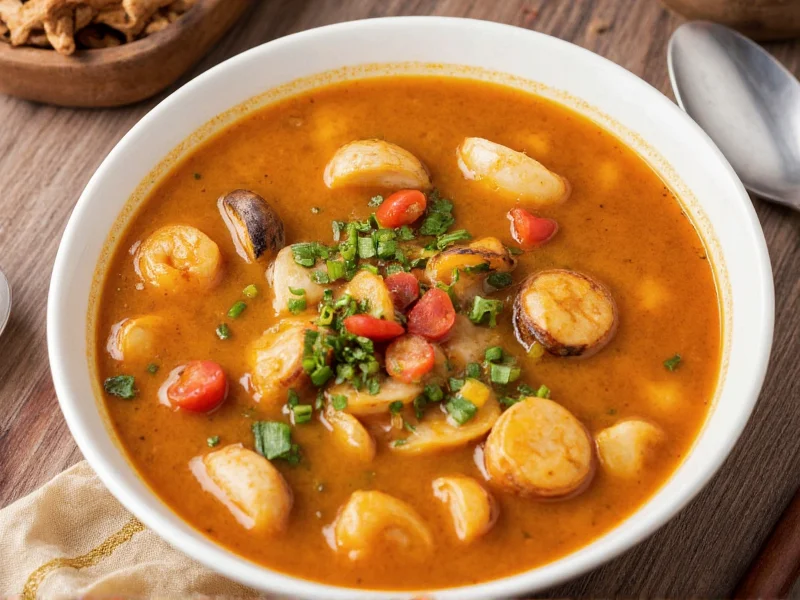Seafood soups represent one of the world's most diverse and nutritionally rich culinary traditions. These flavorful preparations transform fresh marine ingredients into comforting meals that satisfy both taste and nutritional requirements. From coastal communities to fine dining establishments, seafood soups demonstrate remarkable versatility across cultures and cooking skill levels.
Global Varieties of Seafood Soups
Understanding the diverse landscape of seafood soups begins with recognizing their cultural origins. Each region has developed distinctive approaches to combining seafood with complementary ingredients:
| Soup Variety | Origin | Key Ingredients | Distinguishing Feature |
|---|---|---|---|
| Bouillabaisse | France (Marseille) | Rockfish, saffron, garlic, olive oil | Traditional Provençal fisherman's soup served with rouille |
| Cioppino | USA (San Francisco) | Dungeness crab, clams, mussels, tomatoes | Tomato-based broth developed by Italian immigrants |
| Sinigang | Philippines | Tamarind, shrimp, fish, leafy greens | Sour broth featuring indigenous souring agents |
| Caldeirada | Portugal | Multiple fish types, potatoes, peppers | Layered fish stew with distinct regional variations |
| Miso Soup | Japan | Miso paste, dashi, tofu, seaweed | Delicate broth often enhanced with seafood elements |
Essential Ingredients for Perfect Seafood Soups
Creating exceptional seafood soups requires understanding which ingredients work best together. The foundation of any successful seafood soup begins with quality broth or stock. Traditional approaches often start with fish bones or shellfish shells to create a rich base that enhances rather than overwhelms the delicate seafood flavors.
When selecting seafood for soup making, consider both flavor profiles and cooking times. Firm fish like cod or halibut hold their shape well during cooking, while more delicate varieties like sole require careful timing. Shellfish including clams, mussels, and shrimp add distinctive flavors but must be added at precise moments to prevent overcooking. Many authentic seafood soup recipes incorporate a "sofrito" or "mirepoix" of aromatic vegetables including onions, celery, and carrots that build flavor complexity without dominating the marine ingredients.
Nutritional Benefits of Seafood Soups
Seafood soups offer remarkable nutritional advantages that make them valuable additions to balanced diets. These preparations typically deliver high-quality protein with excellent amino acid profiles while remaining relatively low in saturated fats. The omega-3 fatty acids present in many seafood varieties support cardiovascular health and cognitive function.
Traditional seafood soup recipes often incorporate vegetables and herbs that enhance their nutritional profile. Tomatoes in cioppino provide lycopene, while the tamarind in sinigang offers vitamin C and antioxidants. Many seafood soups naturally contain significant amounts of iodine, selenium, and other trace minerals essential for proper metabolic function. When prepared with minimal added fats, these soups can be both satisfying and calorie-conscious meal options.
Step-by-Step Guide to Making Basic Seafood Soup
Creating delicious seafood soup from scratch follows a logical sequence that ensures optimal flavor development and proper cooking of delicate ingredients. Begin by preparing your broth base, whether using homemade fish stock or a quality store-bought alternative. Sauté aromatic vegetables until softened but not browned, then add your liquid base and bring to a gentle simmer.
Timing remains critical when adding seafood components. Start with the densest, slowest-cooking items like fish heads or shellfish shells if making stock from scratch. When incorporating actual seafood, add firm fish first, followed by shellfish, and delicate items like scallops or flaky fish last. Most seafood requires only 3-5 minutes of cooking time in a simmering broth. Overcooking remains the most common mistake in seafood soup preparation, resulting in tough, rubbery textures. Always remove the soup from heat just before the seafood reaches complete doneness, as residual heat will continue the cooking process.
Common Mistakes to Avoid in Seafood Soup Preparation
Even experienced cooks can encounter challenges when preparing seafood soups. Understanding these common pitfalls helps ensure consistently excellent results:
- Overcooking seafood - Most seafood requires minimal cooking time in hot broth
- Using inappropriate seafood - Some varieties break down too quickly in liquid
- Adding salt too early - Seafood naturally releases salt as it cooks
- Boiling instead of simmering - Aggressive boiling destroys delicate textures
- Ignoring acid balance - Proper acidity enhances seafood flavors
Professional chefs emphasize the importance of tasting throughout the cooking process and adjusting seasoning at the end. Many traditional seafood soup recipes incorporate a final "mounting" step with butter or olive oil to enrich the broth's texture and carry flavors more effectively.
Adapting Seafood Soups for Dietary Needs
Modern cooking techniques allow seafood soups to accommodate various dietary requirements without sacrificing flavor. For gluten-free preparations, replace traditional roux with cornstarch or arrowroot for thickening. Dairy-free versions can utilize coconut milk or additional olive oil to achieve creamy textures. Low-sodium adaptations work particularly well with seafood soups, as the natural salinity of marine ingredients provides sufficient seasoning when balanced with acidic components like lemon juice or vinegar.
When modifying authentic seafood soup recipes, maintain respect for the dish's cultural origins while making necessary adjustments. For example, traditional bouillabaisse contains multiple fish varieties and specific Provençal herbs that define its character, while Filipino sinigang relies on distinctive souring agents like tamarind or kamias. Understanding these essential flavor profiles helps maintain authenticity even when adapting for dietary restrictions.
Serving Suggestions and Pairings
The perfect seafood soup experience extends beyond the pot to thoughtful presentation and complementary pairings. Most seafood soups benefit from fresh garnishes added just before serving, such as chopped parsley, cilantro, or chives. Crusty bread remains the classic accompaniment for soaking up flavorful broths, while rice or noodles can transform lighter soups into more substantial meals.
Wine pairings for seafood soups should complement rather than compete with the dish's flavors. Lighter seafood soups pair beautifully with crisp white wines like Sauvignon Blanc or Pinot Grigio, while tomato-based varieties like cioppino work well with medium-bodied reds such as Pinot Noir. For Asian-inspired seafood soups featuring ginger and citrus, consider aromatic whites like Riesling or Gewürztraminer that enhance the dish's bright notes.











 浙公网安备
33010002000092号
浙公网安备
33010002000092号 浙B2-20120091-4
浙B2-20120091-4